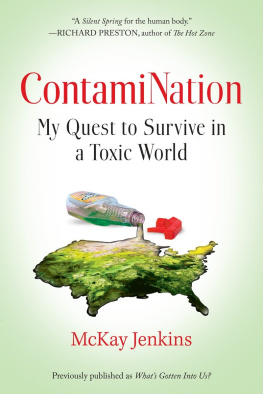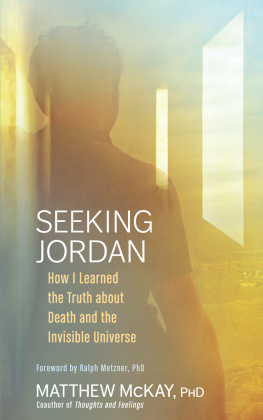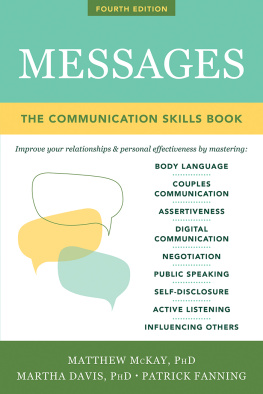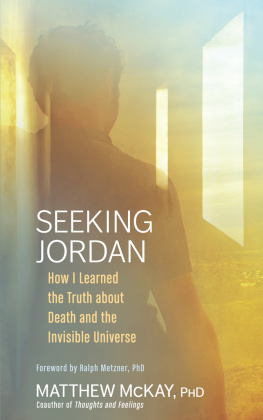Mckay Jenkins - The White Death
Here you can read online Mckay Jenkins - The White Death full text of the book (entire story) in english for free. Download pdf and epub, get meaning, cover and reviews about this ebook. year: 2000, publisher: Knopf Doubleday Publishing Group, genre: Non-fiction. Description of the work, (preface) as well as reviews are available. Best literature library LitArk.com created for fans of good reading and offers a wide selection of genres:
Romance novel
Science fiction
Adventure
Detective
Science
History
Home and family
Prose
Art
Politics
Computer
Non-fiction
Religion
Business
Children
Humor
Choose a favorite category and find really read worthwhile books. Enjoy immersion in the world of imagination, feel the emotions of the characters or learn something new for yourself, make an fascinating discovery.

- Book:The White Death
- Author:
- Publisher:Knopf Doubleday Publishing Group
- Genre:
- Year:2000
- Rating:3 / 5
- Favourites:Add to favourites
- Your mark:
- 60
- 1
- 2
- 3
- 4
- 5
The White Death: summary, description and annotation
We offer to read an annotation, description, summary or preface (depends on what the author of the book "The White Death" wrote himself). If you haven't found the necessary information about the book — write in the comments, we will try to find it.
The White Death — read online for free the complete book (whole text) full work
Below is the text of the book, divided by pages. System saving the place of the last page read, allows you to conveniently read the book "The White Death" online for free, without having to search again every time where you left off. Put a bookmark, and you can go to the page where you finished reading at any time.
Font size:
Interval:
Bookmark:
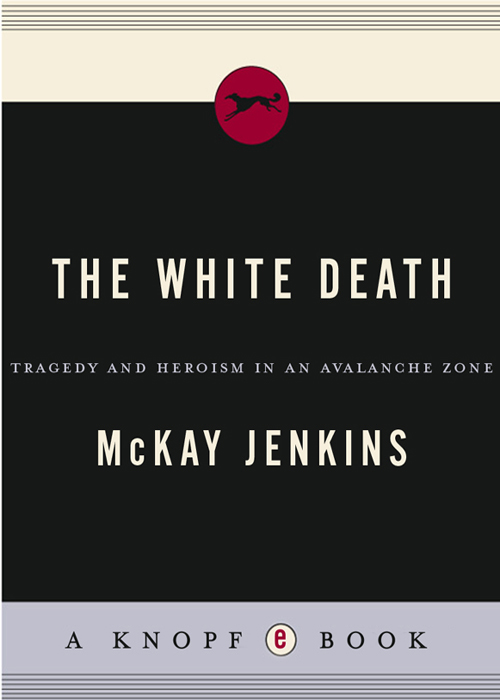
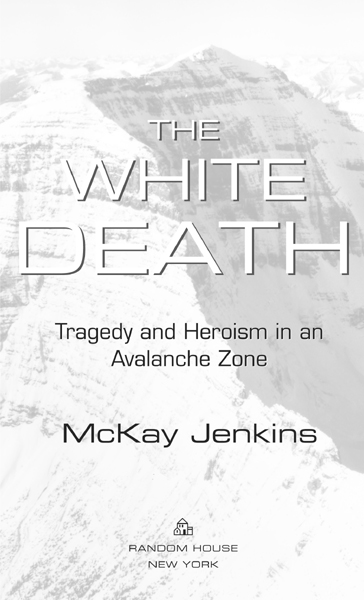
Also by McKay Jenkins
The Peter Matthiessen Reader (editor)
The South in Black and White:
Race, Sex, and Literature in the 1940s
For
Katherine
For
Walter Cumming and Wes Davis
And in memory of
Jerry Kanzler, Clare Pogreba, Ray Martin,
Mark Levitan, and James Anderson
Probably most catastrophes end this way without an ending, the dead not even knowing how they died but still alertly erect in fear and wonder, those who loved them forever questioning this unnecessary death, and the rest of us tiring of this inconsolable catastrophe and turning to the next one.
Norman Maclean,
Young Men and Fire

For their patience and selfless willingness to share difficult memories, I bow to Jean Kanzler, Jim Kanzler, Dr. Morton Levitan, Bud Anderson, Don Anderson, Ruby Martin, Bonnie Schellinger, Esther Gruell, Peter Lev, and Pat Callis.
In and around Glacier National Park, I am indebted to Bob and Ann Frauson, Willie Colony, Jerry DeSanto, Jim Kruger, Charlie Logan, Butch Farabee, and George Ostrom; also Deirdre Shaw, George McFarland, and Ray Cunan at the Glacier Park Museum, Brian Kennedy, former editor of the Hungry Horse News, and the folks at the Izaak Walton Inn, especially Mark Ambre.
In Jackson, thanks to Deb Frauson, Rod Newcomb, and Freddie Botur. Elsewhere, thanks to John Montagne, Terry Kennedy, Robert Madsen, Knox Williams, and the staff of the International Snow Science Workshop. Thanks to Brian Sali for sharing his burial experience, which he courageously first presented at the ISSW conference in Bend, Oregon.
The written work of a number of professional avalanche hunters has proven invaluable, and invigorating. Anyone interested in digging deeper into snow science, mountain history, or avalanche safety is encouraged to look at the work of Monty Atwater, Colin Fraser, Edwin Bernbaum, Ed LaChapelle, Tony Daffern, Bruce Jamieson, Gerald Seligman, Bernard Mergen, and Knox Williams and Betsy Armstrong. A fuller list of suggested reading can be found at the end of this book.
My dear friends Wes Davis, Peter Landesman, Jim Yardley, Walter Cumming, Carla Jenkins, Brian Jenkins, and Monica Frei Jenkins all read early versions of the manuscript and helped immeasurably, as did my agent, Neil Olson, a man of intelligence and grace. Courtney Hodell, my editor at Random House, is a model of vision and clarity; her skills as an editor improved the book enormously. Jennifer Prior copyedited the manuscript and cleaned it up nicely. Thanks also to Tim Farrell and Dennis Ambrose at Random House, and to my research assistant, Chris Bohlman, a fine writer in his own right, and the talented staff of the interlibrary loan office at the University of Delaware. Also, thanks to Tim Burdick and Mark Jeong for their early assistance and expertise; and to Don Jenkins, Denny Jenkins, Ben Yagoda, Chris Sheldrick, Howard and Jill Savin, and Ingrid Hinckley for their enthusiasm and friendship. And to John McPhee and Peter Matthiessen, mentors.
Finally, thanks to my wonderful wife, Katherine, who convinced me after a day of backcountry skiing in Glacier National Park to go sit in on a slide show about avalanches by someone named Bob Frauson. As always, she opened my eyes.

I.
II.
III.

For unless human nature has changed
considerably through the ages, what is
considered news, and therefore may be
remembered when the normal events of daily
life are long forgotten, is the unusual,
particularly the violently unusual. And what is
more violently unusual than a natural
catastrophe?
Dorothy Vitaliano,
Legends of the Earth
One of the stories we have come to tell about wilderness is that disasters are only disasters when people are killed. If a hurricane hits a Caribbean beachhead that has never been developedno homes destroyed, no cars overturned, no electricity knocked outthere wont be any footage of a reporter in foul weather gear, standing out in the rain, describing the terrible scene. If a tidal wave rolls across the Atlantic and fails to flip a single boat, the human community will never hear about it. If a fifty-thousand-ton mud slide obliterates an unpopulated slope somewhere in the middle of the Andes, well never know. Yet the simple point is that these terrific forces exist, and always have; they are as much a part of the interplay between weather systems and geography as sweet sunshine and summer rains. Natural forces become natural disasters only when they get in the way of human endeavor; danger is only danger when it is filtered through the human imagination. This is as true for inanimate forces as it is for so-called dangerous animalswolves, grizzly bears, great white sharkswhich have been systematically sought out and destroyed to eliminate human fear. The trouble with hurricanes, and tidal waves, and mud slides is that they cant be hunted down and shot.
There are few more dangerous places on earthfew places where it is easier for people to diethan the high mountains. Pilgrims looking for God, miners looking for gold, mountaineers looking for both: all have found mountains unmoved, indifferent to their noble intentions as well as their base ones. Throughout recorded history, legends abound detailing the dangers that come to those foolish enough to test the worlds high places. Russian, Czech, and Slovak folklore tells of mountain creatures with the face of a woman, the body of a sow, and the legs of a horse. When storms raged in Germany, villagers believed that the ghostly Wild Huntsman was abroad with his pack of baying hounds, riding furiously and slaughtering everything in his path. In the fifteenth century, mountain travelers were often led through the high places blindfolded, since the Alps were thought to contain visions that might drive them mad. Residents of the Swiss mountains believed that atop the Matterhorn was a ruined city inhabited by the souls of the dead. The East African Mountains of the Moon, given their name by Ptolemy, were thought to be so enticing that whoever looked upon their snowy peaks would be drawn to them as if by a magnetic pull, and could only be released by death. Echoes were the voices of ghosts, storms the carnal revels of Satan and his witches.
For centuries, Europeans avoided climbing mountains, for fear of upsetting the dragons they knew to inhabit them. Some of these beasts were thought to look like serpents with the heads of cats, others had bat wings and long, hairy tails; an eighteenth-century scholar gathered depositions, given under oath, about these beasts. There are dragons with and without wings, it was reported, with and without legs, with and without crests; dragons with cat faces, with human faces, and with nondescript faces; dragons that breathe fire and that do not breathe fire. An Alpine traveler named Johann Scheuchzer wrote in his 1723 book Itinera Alpina that although surely some dragons were fables... from the accounts of Swiss dragons, and their comparison with those of other lands, such animals do exist. Early Europeans were content to leave the mountains be, to live by the rivers, travel the valleys, and, only when necessity compelled, to cross high passes. When wars or pilgrimages or the search for new horizons demanded that they cross these passes in winter, travelers often found their greatest fears realized. The old myths were right. Dragons did exist. Not as fire-breathing beasts, but as avalanches.
Font size:
Interval:
Bookmark:
Similar books «The White Death»
Look at similar books to The White Death. We have selected literature similar in name and meaning in the hope of providing readers with more options to find new, interesting, not yet read works.
Discussion, reviews of the book The White Death and just readers' own opinions. Leave your comments, write what you think about the work, its meaning or the main characters. Specify what exactly you liked and what you didn't like, and why you think so.



